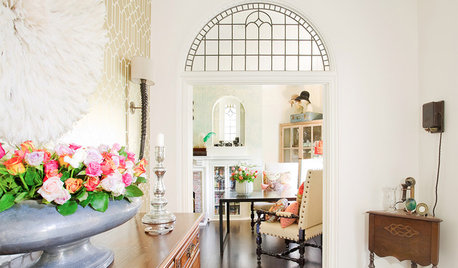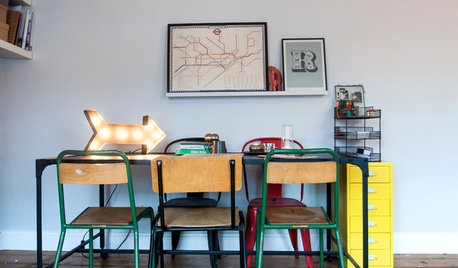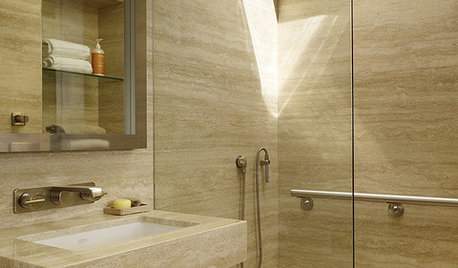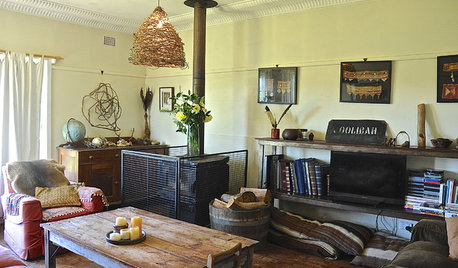July 5, 2007
In the Garden
A Cane the World Can Lean On
By ANNE RAVER
Mount Vernon, Wash.
{{gwi:416419}}
BAMBOO is a versatile, ancient plant that shows up in creation myths as well as in pots on Manhattan terraces. It comes in clumping varieties that behave themselves and running "timber" types that spread by rhizomes great for a grove, but not so good when they are planted as a property screen that escapes into a neighborÂs yard.
But itÂs that very vigor that has environmentalists hailing bamboo as the new "It" plant for saving the earth.
Bamboo is a workhorse at sequestering carbon dioxide and pumping out oxygen. It is a tough plant that manufactures its own antibacterial compounds and can thrive without pesticides. And its porous fibers make a cloth that breathes and is as soft as silk. In fact, there is such a stampede of fabric designers to China and Japan, where it is farmed and processed  no such industry exists in the United States  that in its May issue, National Geographic predicted that "this upstart fabric may someday compete with King Cotton."
Yet as the world clamors for more, bamboo is in short supply. A plant that generally flowers only every 60 to 120 years and then dies is hard to propagate from seed. And growing it by dividing existing plants is notoriously difficult.
So when Jackie Heinricher and Randy Burr figured out how to make bamboo in test tubes  selling their first 2,000 plants in 2004 to local garden centers in the Skagit Valley in Washington  they made waves in the world of horticulture.
"ItÂs funny, because bamboo has this reputation for taking over the universe, and yet itÂs the hardest plant to produce," Ms. Heinricher, a biologist, said one afternoon in early June at the production center for her company, Boo-Shoot Gardens, here in Mount Vernon, a town about two hours north of Seattle.
Ms. Heinricher, who grew up with bamboo  her father tended golden bamboos all around their house in Olympia, Wash.  first tried to propagate the plant in the late 1990Âs in a little greenhouse at her home in nearby Anacortes, where she lives with her husband, Guy Thornburgh, a marine biologist, and where she founded Boo-Shoot Gardens in 1998.
"I got interested in noninvasive bamboos early on, knowing that they were very beautiful, but impossible to make," Ms. Heinricher said. She quickly realized just how impossible, as she tried to divide some of her own rare specimens and watched many die.
So she persuaded Mr. Burr, an owner of the nearby B&B Laboratories, to help her. Mr. Burr and his company had been in business for almost 30 years, with a 14,000-square-foot tissue culture lab and 40,000 square feet of greenhouses. B&B had pumped out plants as varied as rhododendrons and cauliflower, and had figured out how to tissue-culture the Boston fern in 1973, for a nursery in Oxnard, Calif., and thousands of other plants.
"But bamboo was the hardest," Mr. Burr said, looking back over eight years of trying seemingly endless combinations of variables to trigger bamboo to regenerate in a test tube.
When I asked what finally worked, Mr. Burr stared back deadpan and said, "WeÂd have to shoot you."
Bamboo can be as delicate as the umbrella bamboo, Fargesia murieliae, a clumper with soft pea-green foliage and a weeping habit, or as heroic as Phyllostachys edulis, whose sturdy olive-green canes can grow 70 feet in a single season.
Bamboo fibers are a renewable resource for fabric, food and paper. And experimental plantings in Alabama financed by the Agriculture Department between 1933 and 1965 showed bambooÂs promise for paper and other wood products: bamboo produced 14 tons of wood an acre, as against 8 for loblolly pine, a major source of timber in the United States.
Planted in large groves, bamboo can store "four times the CO2 of a stand of trees of similar size," Ms. Heinricher said, citing a study by Jules A. Janssen of the Technical University Eindhoven in the Netherlands, in 2000. "And," she said, "it releases 35 percent more oxygen."
For now, though, Ms. Heinricher is concentrating on bamboos for the garden: ground covers that can replace lawns, well-behaved clumpers that can be planted in pots or as screens, and tall timber bamboos for those who have the room. The timber species are not invasive, she insists, if you put them in the right place with plenty of room, and maintain their growth by planting them on a mound, encircled by a shallow trench, about 10 inches wide and 8 inches deep, where the rhizomes can be cut easily when they travel.
Many of these plants can now be produced on a vast scale, which is revolutionary for the garden industry. Countries like Belgium have explored the tissue-culturing of bamboo, but Boo-Shoots appears to be taking the lead.
"I believe that Jackie is the first in America to figure out how to produce bamboo from tissue culture," said Nicholas Staddon, the director of plant introductions for Monrovia, a wholesale grower with five locations in the United States. "She has made a substantial difference in how we bring plants to market."
In the old days, bamboo had to be divided and grown to marketable size in a cycle lasting three to five years. Now Monrovia and other growers can buy trays full of young plants from Boo-Shoots, which are potted up and sold as a finished product to other wholesalers and retail nurseries across the country.
"There is a tremendous trend in the industry to use bamboo in the garden, and also in containers," Mr. Staddon said. "And Jackie is working on varieties of bamboo which we are unfamiliar with, or have not been able to produce or acquire."
Developing tissue culture is a time-consuming process, Mr. Burr explained, in which a tiny cutting is sterilized in bleach, then put into a soup, or agar, of inorganic salts, plant sugars, hormones, vitamins and "all the building-block components that encourage tissue to generate and shoot new growth." Getting that formula right can take years.
{{gwi:416420}}
And the rooting stage is tricky, too. "WeÂd put out 10,000 plants and lose 10,000," Ms. Heinricher said.
In early January, Ms. HeinricherÂs company, Boo-Shoots, bought B&B Laboratories and its growing center from Mr. Burr and his partners, and she asked him to focus solely on propagating additional species of bamboo. In the spring, they shipped 150,000 bamboo plants to wholesale growers like Monrovia and Hines in California, Prides Corner Farms in Connecticut and garden centers and mail-order houses like Plant Delights in Raleigh, N.C.
"ThatÂs 24 different bamboos, all from tissue culture," Ms. Heinricher said. "And we have 42 different kinds in production." In 2008 the goal is to ship out 250,000.
Growing bamboo from seed or by division creates plants of different sizes, forms and colorations. But each species of these bamboos, growing by the tens of thousands in the Mount Vernon greenhouses, is amazingly uniform.
Ms. Heinricher and I walked by long tables full of Borinda boliana, a clumping bamboo whose new canes come up pale blue, then turn to burgundy and purple, and Fargesia rufa, or Sunset Glow, a cold-hardy clumper with orange-red cane sheaths that make a good screen or hedge. There were ground covers, too, like Pleioblastus viridistriatus, or Dwarf Green Stripe, which has chartreuse leaves striped with dark green ribbons.
"People are starting to use these as an alternative to lawn," Ms. Heinricher said, running her fingers over the soft leaves. "You can walk on it. And if you mow it, it stays really tiny."
IÂve always been fascinated by bamboo, especially the so-called timber species, with their giant gold, black and striped canes, which can range from 20 to 100 feet. (Remember the scene in "Crouching Tiger, Hidden Dragon," when Ziyi Zhang leaps across a lush grove of towering bamboo that bends and sways to her every move?) But IÂve been afraid to grow it, thinking of those nightmarish stories about bamboo running across the neighbors lawns.
But Ms. Heinrich is determined to teach people how to choose the right plants, and how to maintain even the most vigorous growers. (Her booklet, "Discovering Bamboo," available at booshootgardens.com, describes how to cultivate and maintain it.)
In her seven-acre garden in Anacortes, which is open by appointment, I admired many of the well-behaved bamboos around the Japanese-style guesthouse. But it was the tall timber types that drew me up the hill. Thousands of birds seemed to be nesting there, and the canes were swaying in the evening breeze.
It was shooting time in the garden, and that is what we had come to see: every spring, the buds on underground rhizomes suddenly pop out of the ground and begin to grow at an amazing rate. Phyllostachys nigra, the black bamboo, was sending up shoots about three inches in diameter and four feet tall. Within a month they would attain their full height  about 40 feet  but they wouldnÂt get any thicker. Unlike tree trunks, bamboo canes do not grow in diameter; the following yearÂs new shoots will simply be a bit thicker, and so on, with each succeeding year.
{{gwi:416422}}
We wandered about the groves, riveted by those shoots  some pale green, some golden, others inky black and satiny smooth. No wonder this plant inspires creation myths. Pieces of bamboo were said to have been found around BuddhaÂs remains.
"ItÂs probably the most sacred plant for everyone in the world, except the U.S., because of all that it does," Ms. Heinricher said.
Bamboo shoots can be eaten, parboiled or stir-fried if you pop them off underground, just before they emerge from the dirt. ThatÂs one way to control your bamboo: eat it for dinner.
I still wonder what happens if the responsible gardener moves away or dies. But bamboo is shallow-rooted. If you want to get rid of a grove, Ms. Heinricher said, you use a spade with a sharp edge to cut through the rhizomes; then shove the spade beneath the roots, which generally go about a foot down, and peel the whole mat off the ground.
"IÂve dug up 40-foot canes, in 20-by-20 groves, that way," she said.
I stared up at the 70-footers. Maybe I would have to come back in a year, to eat a few shoots, and to help Ms. Heinricher peel up a grove.
Copyright 2007 The New York Times Company
















naplesgardener
Related Professionals
Middle Island Landscape Architects & Landscape Designers · Mitchellville Landscape Architects & Landscape Designers · Waunakee Landscape Architects & Landscape Designers · Fruit Heights Landscape Contractors · Hayward Landscape Contractors · Lakeville Landscape Contractors · Norristown Landscape Contractors · Wanaque Landscape Contractors · Hawaiian Gardens Landscape Contractors · Saint Charles Carpenters · Salem General Contractors · Browns Mills General Contractors · Deer Park General Contractors · Endicott General Contractors · Syosset General Contractors